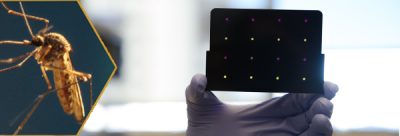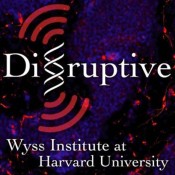Disruptive #7: FISSEQ – Fluorescent In Situ Sequencing
Written on October 7th, 2016Until recently, to analyze many mRNAs simultaneously, scientists had to grind cells to a pulp, which left them unable to pinpoint those mRNAs within the cell. Developed by a team at the Wyss and Harvard Medical School, FISSEQ allows scientists to pinpoint thousands of mRNAs and other types of RNAs at once in intact cells, and stands to revolutionize clinical diagnostics and drug discovery.
Listen and subscribe to Disruptive on Soundcloud, iTunes, or Google Play.
Disruptive Episode #7 – FISSEQ – Fluorescent In Situ Sequencing
Written on October 5th, 2016DISRUPTIVE #7: FISSEQ – Fluorescent In Situ RNA Sequencing
Hello, I’m Terrence McNally and you’re listening to DISRUPTIVE the podcast from Harvard’s Wyss Institute for Biologically Inspired Engineering.
One of today’s guests, George Church, has made the point that as medicine moves from very blunt instruments – where you had to open up a chest all the way, for example, or had to use molecules that would hit almost every part of your body – now molecules can find one base pair out of six billion and change it – He says we need observational tools that can deal with that high level of resolution and comprehensiveness.
And we’re going to talk about one such tool. Fluorescent in situ RNA sequencing – F-I-S-S-E-Q – or FISSEQ.
Working copies of active genes — called messenger RNAs or mRNAs — are strategically positioned throughout living tissues, and their location often helps regulate how cells and tissues grow and develop. Until recently, to analyze many mRNAs simultaneously, scientists had to grind cells to a pulp, which left them unable to pinpoint where those mRNAs actually sat within the cell.
Now a team at the Wyss Institute and Harvard Medical School has developed a new method that allows scientists to pinpoint thousands of mRNAs and other types of RNAs at once – in intact cells.
FISSEQ could lead to earlier cancer diagnosis, help biologists better understand embryonic development, and even help map the neurons of the brain.
I’ll talk with George Church, Wyss Core Faculty member and co-founder of ReadCoor, the startup that will bring FISSEQ to market; Wyss lead senior scientist, Rich Terry, President, Co-Founder, and CTO of ReadCoor; and Shawn Marcell, Wyss Entrepreneur-in-Residence and founding Chairman/CEO of ReadCoor.
The mission of the Wyss Institute is to: Transform healthcare, industry, and the environment by emulating the way nature builds.
Our bodies — and all living systems — accomplish tasks far more sophisticated and dynamic than any entity yet designed by humans.
By emulating nature’s principles for self-organizing and self-regulating, Wyss researchers develop innovative engineering solutions for healthcare, energy, architecture, robotics, and manufacturing. [02:06]
George Church is Professor of Genetics at Harvard Medical School and Professor of Health Sciences and Technology at Harvard and MIT. He’s Director of the U.S. Department of Energy Center on Bioenergy at Harvard and MIT and director of the NIH Center for Excellence in Genomic Science at Harvard. He has co-founded a number of companies, including ReadCoor.
Church earned a bachelor’s degree from Duke University in two years and a PhD from Harvard. Honors include election to the National Academy of Sciences and the National Academy of Engineering. He has coauthored hundreds of scientific papers, more than sixty patents, and the book, “Regenesis: How Synthetic Biology Will Reinvent Nature and Ourselves.” [02:41]
To set the context for this episode, George Church offers an overview of the evolution of sequencing technology –
Church: It dates back at least to the ’60s when RNA sequencing and protein sequencing were the main ways of getting insight. In the mid-’70s, ways to do DNA sequencing based on electrophoresis came into play. Those were automated and made less radioactive, more fluorescent. In the ’80s and ’90s, it switched from slab electrophoresis, capillary electrophoresis. None of these scaled particularly well.
Continue reading “Disruptive Episode #7 — FISSEQ — Fluorescent In Situ Sequencing”
Disruptive#6: Rapid, Low-cost, Paper-based Test for Zika
Written on June 24th, 2016
Disruptive: Synthetic Biology Pamela Silver & George Church
Written on February 21st, 2016
I’m excited to offer the first episode of DISRUPTIVE, my new monthly podcast series produced with Harvard’s Wyss Institute for Biologically Inspired Engineering. The mission of the Wyss Institute is to: Transform healthcare, industry, and the environment by emulating the way nature builds, with a focus on technology development and its translation into products and therapies that will have an impact on the world in which we live. Their work is disruptive not only in terms of science but also in how they stretch the usual boundaries of academia.
In this inaugural episode, Wyss core faculty members Pamela Silver and George Church explain how, with today’s technology breakthroughs, modifications to an organism’s genome can be conducted more cheaply, efficiently, and effectively than ever before. Researchers are programming microbes to treat wastewater, generate electricity, manufacture jet fuel, create hemoglobin, and fabricate new drugs. What sounds like science fiction to most of us might be a reality in our lifetimes: the ability to build diagnostic tools that live within our bodies, find ways to eradicate malaria from mosquito lines, or possibly even make genetic improvements in humans that are passed down to future generations. Silver and Church discuss both the high-impact benefits of their work as well as their commitment to the prevention of unintended consequences in this new age of genetic engineering.
DISRUPTIVE: BIO-INSPIRED ROBOTICS features three separate interviews with (1) RADHIKA NAGPAL, (2) ROBERT WOOD, and (3) CONOR WALSH
Written on October 7th, 2015
Welcome to the second episode of my new monthly podcast series produced with Harvard’s Wyss Institute for Biologically Inspired Engineering.
DISRUPTIVE: BIO-INSPIRED ROBOTICS features three separate interviews with (1) RADHIKA NAGPAL, (2) ROBERT WOOD, and (3) CONOR WALSH. From insects in your backyard, to creatures in the sea, to what you see in the mirror, engineers and scientists at Wyss are drawing inspiration to design a whole new class of smart robotic devices
In this one, ROBERT WOOD discusses new manufacturing techniques that are enabling popup and soft robots. His team’s ROBO-BEE is the first insect-sized winged robot to demonstrate controlled flight.
In part one, RADHIKA NAGPAL talks about her work Inspired by social insects and multicellular systems, including the TERMES robots for collective construction of 3D structures, and the KILOBOT thousand-robot swarm. She also speaks candidly about the challenges faced by women in the engineering and computer science fields.
In part three, CONOR WALSH discusses how a wearable robotic exosuit or soft robotic glove could assist people with mobility impairments, as well as how the goal to create real-world applications drives his research approach.
The mission of the Wyss Institute is to: Transform healthcare, industry, and the environment by emulating the way nature builds, with a focus on technology development and its translation into products and therapies that will have an impact on the world in which we live. Their work is disruptive not only in terms of science but also in how they stretch the usual boundaries of academia.
http://wyss.harvard.edu/
– See more at:
DISRUPTIVE: BIO-INSPIRED ROBOTICS Radhika Nagpal Interview
DISRUPTIVE: BIO-INSPIRED ROBOTICS Conor Walsh Interview
Robert Wood’s interview transcript




